Effect of Cow Dung Additions on Tropical and Mediterranean Earth Mortars-Mechanical Performance and Water Resistance
Abstract
:1. Introduction
2. Materials and Methods
2.1. Materials
2.1.1. Earth
2.1.2. Sand
2.1.3. Cow Dung
2.2. Mortars and Samples
2.3. Mortar Test Methods
3. Results
3.1. Linear Drying Shrinkage
3.2. Apparent Dry Bulk Density
3.3. Flexural and Compressive Strengths
3.4. Adhesive Shear Strength
3.5. Immersion in Water
4. Conclusions
Author Contributions
Funding
Institutional Review Board Statement
Informed Consent Statement
Data Availability Statement
Acknowledgments
Conflicts of Interest
References
- Zhang, Y.; Jiang, S.; Quan, D.; Fang, K.; Wang, B.; Ma, Z. Properties of Sustainable Earth Construction Materials: A State-of-the-Art Review. Sustainability 2024, 16, 670. [Google Scholar] [CrossRef]
- Lima, J.; Faria, P.; Santos Silva, A. Earth plasters: The Influence of Clay Mineralogy in the Plasters’ Properties. Int. J. Archit. Heritage 2020, 14, 948–963. [Google Scholar] [CrossRef]
- Mileto, C.; López-Manzanaraes, F.V. The COREMANS Project. Intervention Criteria for Earthen Architecture; Ministerio de Educación, Cultura Y Deporte: Madrid, Spain, 2017. (In Spanish)
- DIN 18947; Earth Plasters–Terms and Definitions, Requirements, Test Methods. NABau: Berlin, Germany, 2024. (In Germany)
- ZRS. Available online: https://www.zrs.berlin/en/article/new-generation-of-earth-building-standards/ (accessed on 5 April 2024).
- Bamogo, H.; Ouedraogo, M.; Sanou, I.; Ouedraogo, K.A.J.; Dao, K.; Aubert, J.-E.; Millogo, Y. Improvement of water resistance and thermal comfort of earth renders by cow dung: An ancestral practice of Burkina Faso. J. Cult. Heritage 2020, 46, 42–51. [Google Scholar] [CrossRef]
- Pachamama, R.N.; Rezende, M.A.P.; Junior, A.N.C.; Barbosa, R.A.; Moraes, P.M. Earth mortars: A vernacular technology and a modern eco-efficient solution. Int. J. Dev. Res. 2020, 10, 40329–40335. [Google Scholar]
- Munshi, S.K.; Roy, J.; Noor, R. Microbiological investigation and determination of the antimicrobial potential of cow dung samples. Stamford J. Microbiol. 2018, 8, 34–37. [Google Scholar] [CrossRef]
- Gupta, K.K.; Aneja, K.R.; Rana, D. Current status of cow dung as a bioresource for sustainable development. Bioresour. Bioprocess. 2016, 3, 28. [Google Scholar] [CrossRef]
- Ma, Y.; Wu, S.; Zhuang, J.; Tong, J.; Qi, H. Tribological and physio-mechanical characterization of cow dung fibers reinforced friction composites: An effective utilization of cow dung waste. Tribol. Int. 2019, 131, 200–211. [Google Scholar] [CrossRef]
- Worku, M.A.; Taffese, W.Z.; Hailemariam, B.Z.; Yehualaw, M.D. Cow dung ash in mortar: An experimental study. Appl. Sci. 2023, 13, 6218. [Google Scholar] [CrossRef]
- Kumar, D.J.; Surendra, R. Utilization of fly ash and cow dung ash as partial replacement of cement in concrete. Int. J. Civ. Struct. Eng. 2015, 6, 34–39. [Google Scholar]
- Manette, N.; Oyawa, W.; Nyomboi, T. Potential of quarry dust and cow dung as stabilizers for black cotton soil eco-blocks for housing. Civil Environ. Res. 2015, 7, 117–124. [Google Scholar]
- Santos, D.P.; Sousa, J.G.G. Avaliação das Propriedades Físicas e Mecânicas de Adobes com Incorporação de Adições Naturais. In Proceedings of the 7th Congresso Brasileiro de Arquitetura e Construção com Terra no Brasil, Rio de Janeiro, Brazil, 30 October–2 November 2018; pp. 102–113. [Google Scholar]
- Yalley, P.P.-K.; Dorothy, M. Strength and Durability Properties of Cow Dung Stabilized Earth Brick. Civ. Env. Res. 2013, 3, 117–125. [Google Scholar]
- Pachamama, R.N.; Rezende, M.A.P.; Faria, P. Eco-efficient earth plasters: Effect of cow dung and air lime on a kaolinitic clayish earth. Int. J. Dev. Res. 2020, 10, 39323–39328. [Google Scholar]
- Ashurst, J.; Ashurst, N. Practical Building Conservation: Brick, Terracotta and Earth, 1st ed.; Ashgate and Historic England: London, UK, 1988; Volume 2. [Google Scholar]
- Kulshreshtha, Y.; Vardon, P.J.; Meesters, G.M.H.; Van Loosdrecht, M.C.M.; Mota, N.; Jonkers, H.M. What Makes Cow-Dung Stabilized Earthen Block Water-Resistant? Const. Technol. Archit. 2022, 1, 540–548. [Google Scholar]
- Millogo, Y.; Aubert, J.E.; Séré, A.D.; Fabbri, A.; Morel, J.C. Earth blocks stabilized by cow-dung. Mater. Struct. 2016, 49, 4583–4594. [Google Scholar] [CrossRef]
- EN 1015-1; Methods of Test for Mortar for Masonry-Part 1: Determination of Particle Size Distribution (by Sieve Analysis). CEN: Brussels, Belgium, 1998.
- NBR 7181; Soil–Granulometry Analysis. ABNT—Associação Brasileira de Normas Técnicas: Rio de Janeiro, Brazil, 2016. (In Portuguese)
- NP 143; Determination of Consistency Limits. Laboratório Nacional de Engenharia Civil: Lisboa, Portugal, 1969. (In Portuguese)
- EN 1097-3; Tests for Mechanical and Physical Properties of Aggregates. Part 3: Determination of Loose Bulk Density and Voids. CEN: Brussels, Belgium, 1998.
- EN 1015-3; Methods of Test for Mortar for Masonry. Part 3: Determination of Consistence of Fresh Mortar (by Flow Table). CEN: Brussels, Belgium, 1999.
- EN 1015-6; Methods of Test for Mortar for Masonry. Part 6: Determination of Bulk Density of Fresh Mortar. CEN: Brussels, Belgium, 1998.
- Hamard, E.; Morel, J.-C.; Salgado, F.; Marcom, A.; Meunier, N. A procedure to assess the suitability of plaster to protect vernacular earthen architecture. J. Cult. Herit. 2013, 14, 109–115. [Google Scholar] [CrossRef]
- EN 1015-10; Methods of Test for Mortars for Masonry. Part 10: Determination of Dry Bulk Density of Hardened Mortar. CEN: Brussels, Belgium, 1999.
- EN 1015-11; Methods of Test for Mortar for Masonry. Part 11: Determination of Flexural and Compressive Strength of Hardened Mortar. CEN: Brussels, Belgium, 2019.
- Walter, L.; Medjigbodo, G.; Claudot, L.; Nait-Rabah, O.; Linguet, L. Influence of metal oxides and particle size on earthen mortar built with tropical soils. Acad. J. Civil Eng. 2022, 40, 2. [Google Scholar]
- Santos, T.; Faria, P.; Santos Silva, A. Eco efficient earth plasters: The effect of sand grading and additions. J. Build. Eng. 2020, 33, 101591. [Google Scholar] [CrossRef]


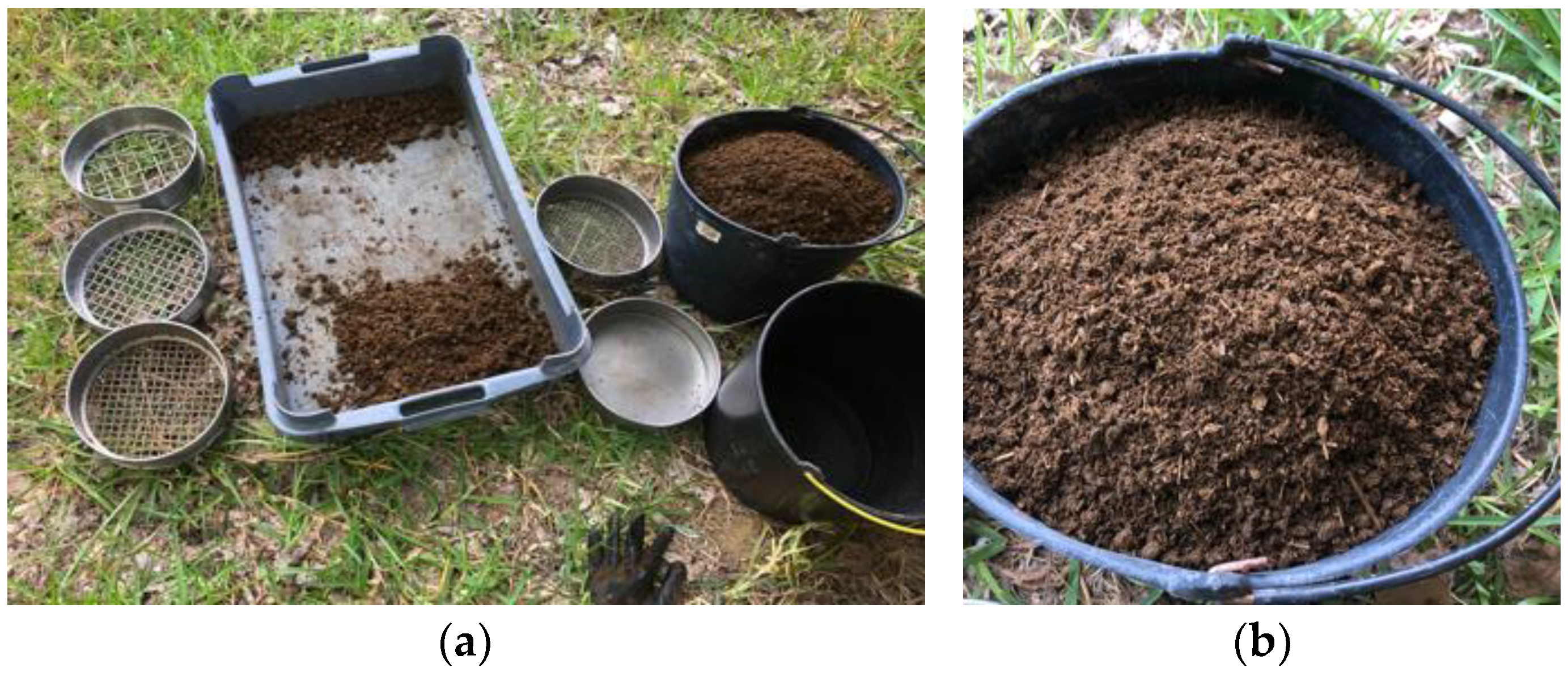
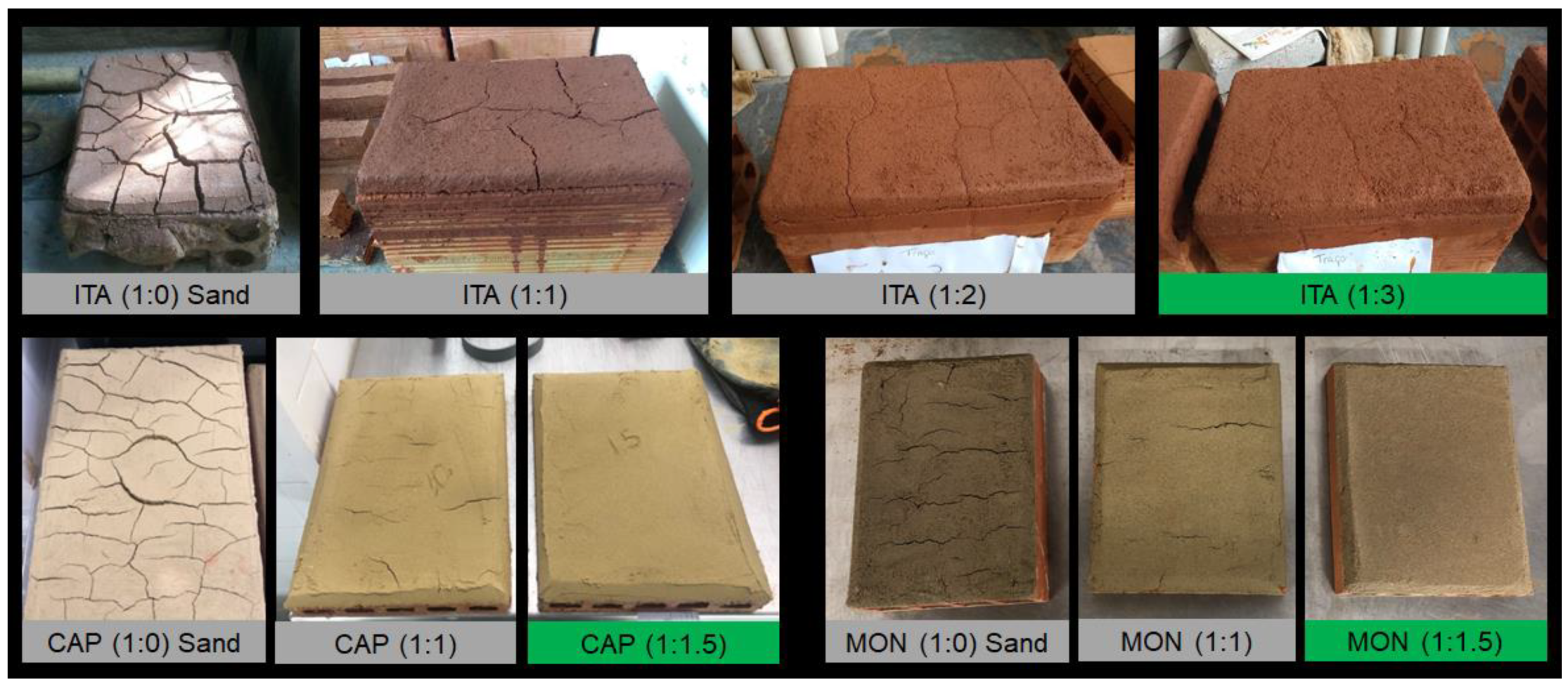
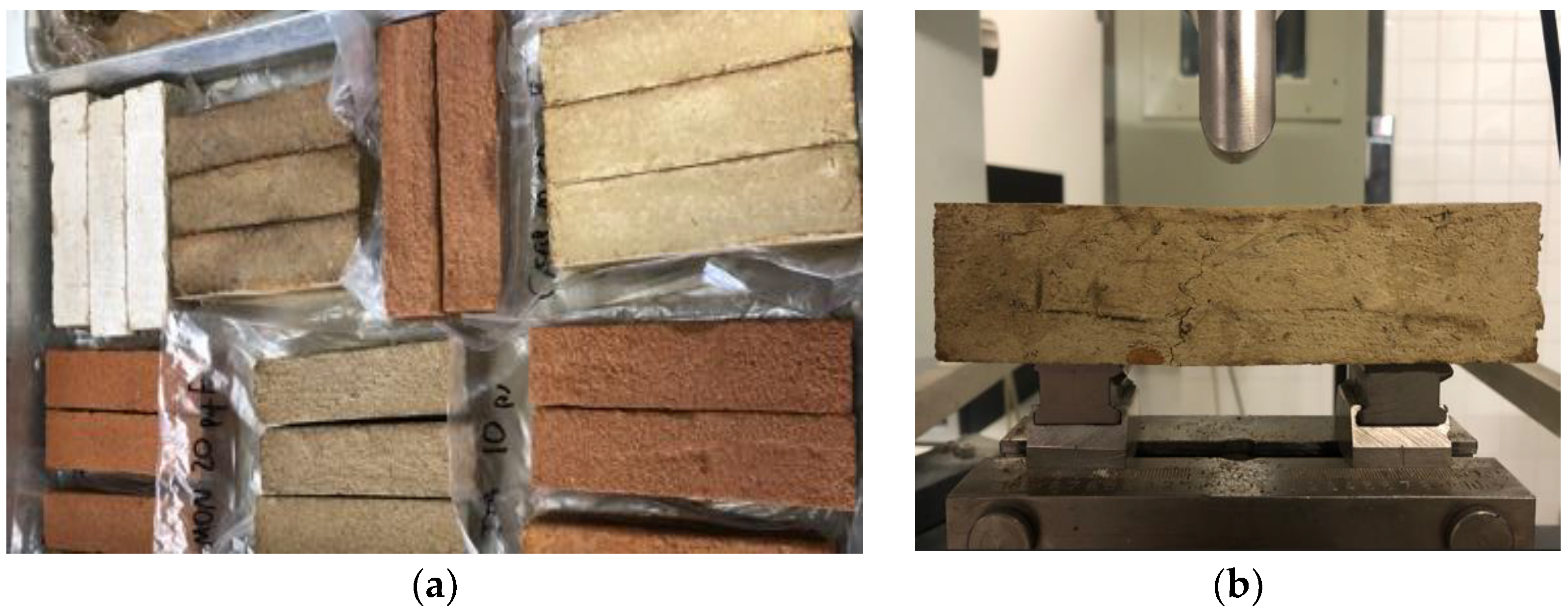

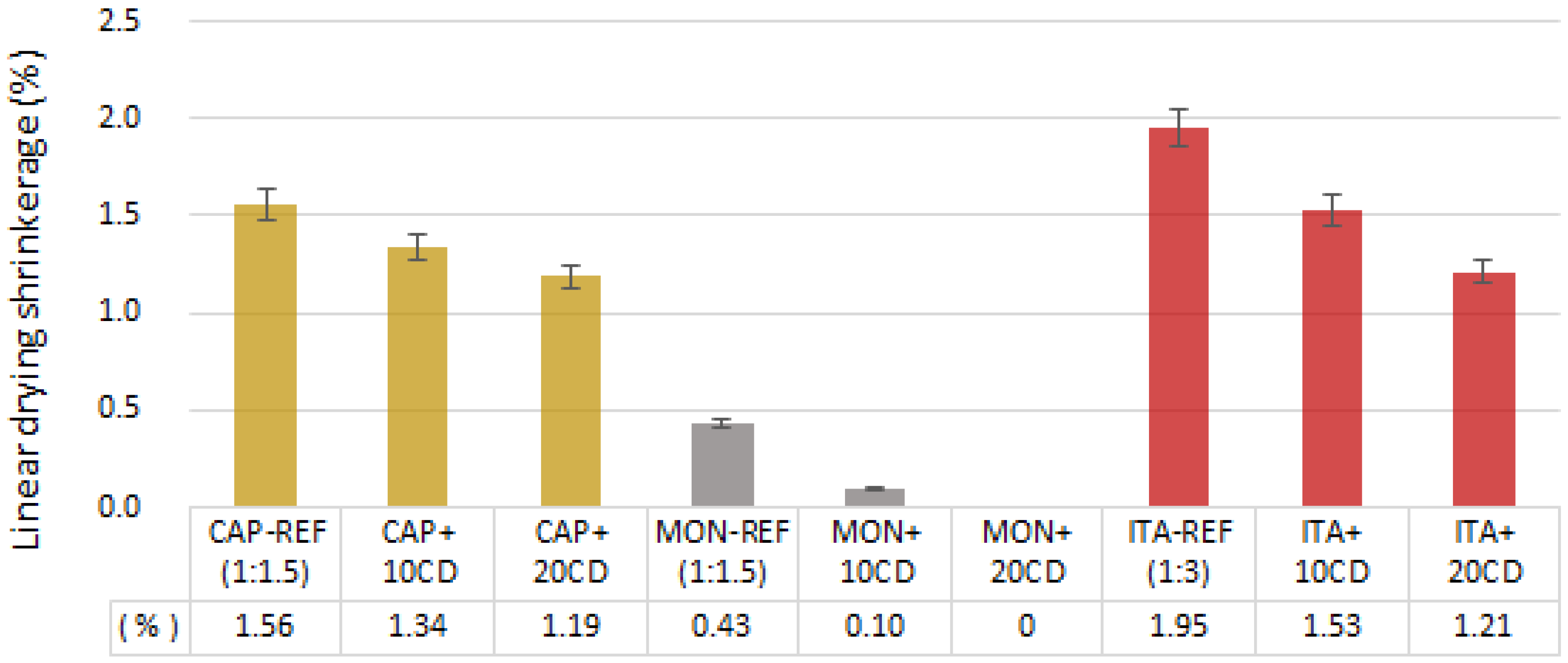
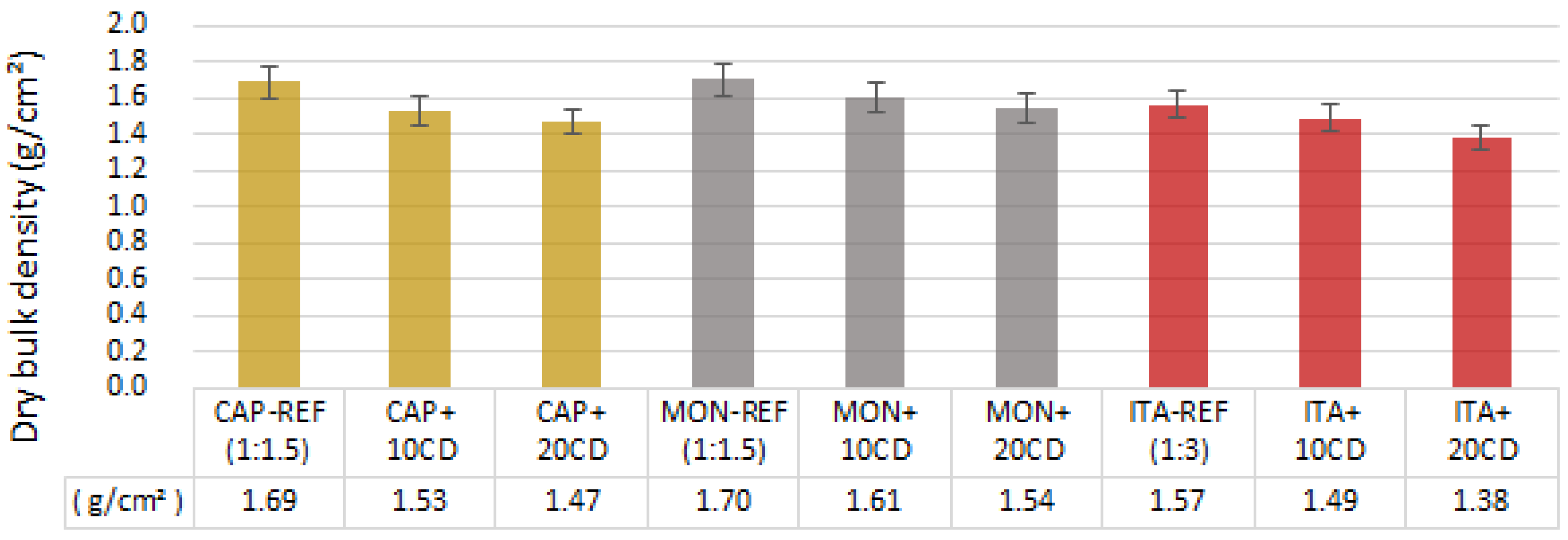

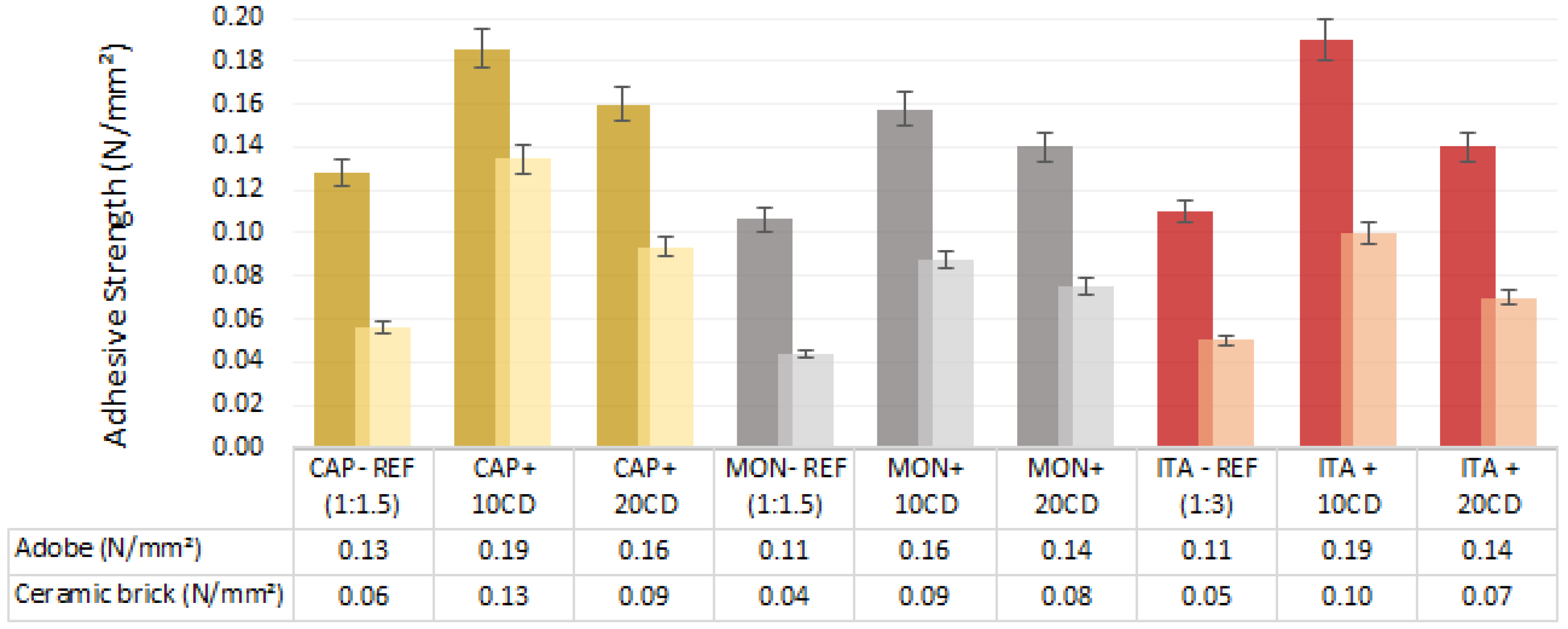

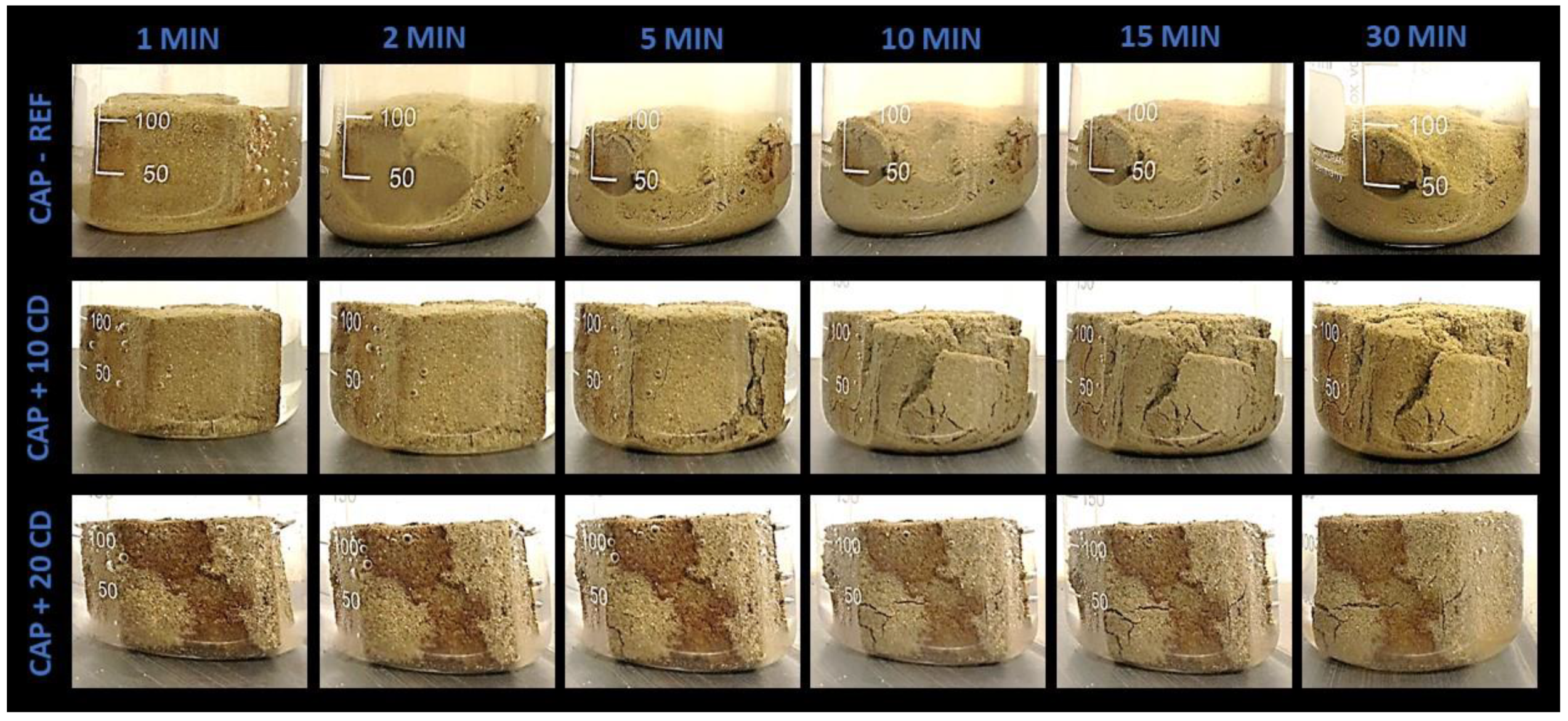
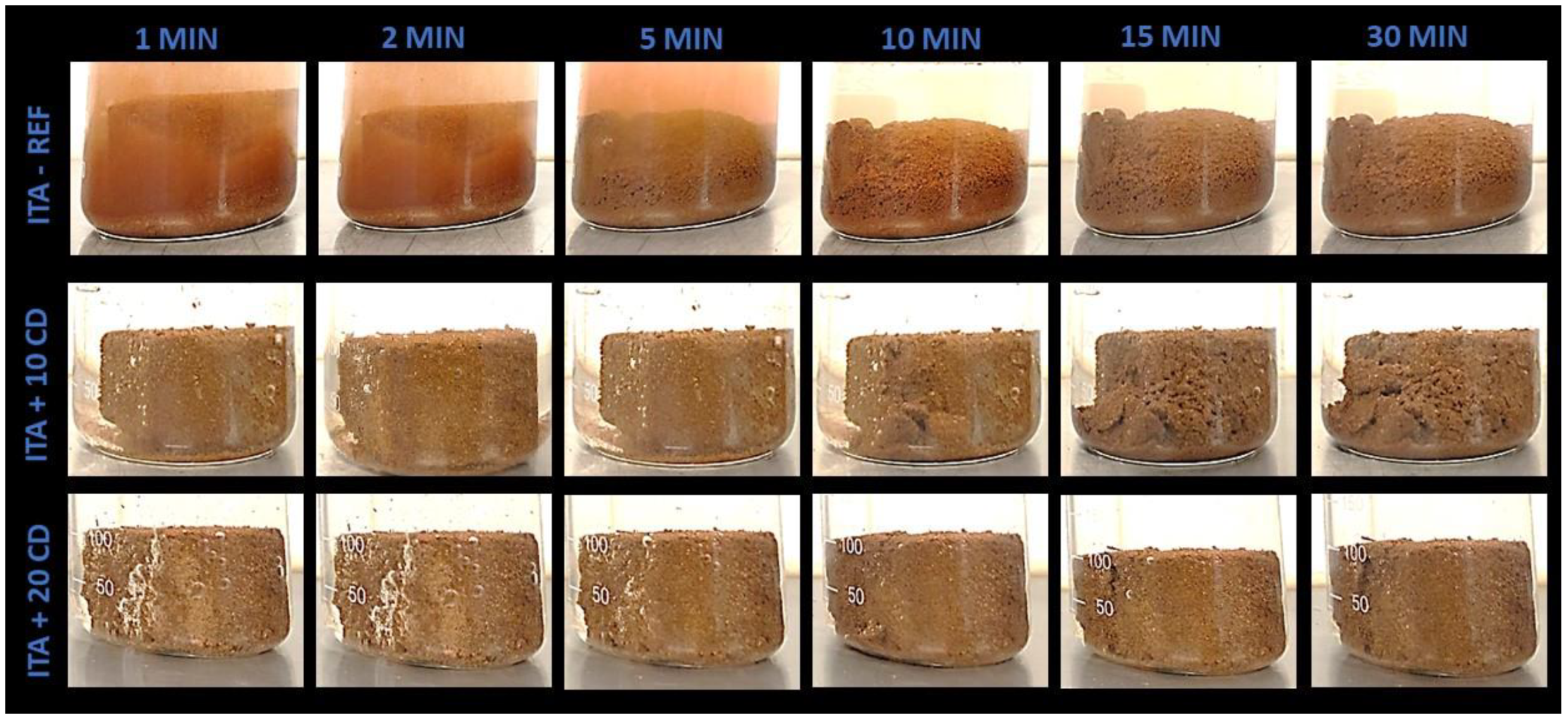
| Crystalline Compounds | CAP (%) | MON (%) | ITA (%) |
|---|---|---|---|
| Quartz—SiO2 | 51.2 | 33.6 | 22.1 |
| Feldspar (microcline)—KAlSi3O8 | 9.7 | 5.2 | - |
| Feldspar (albite)—NaAlSi3O8 | 17.5 | 40.2 | - |
| Mica (muscovite)—KAl2(Si3Al)O10(OH,F)2 | 9.6 | - | - |
| Mica (illite)—(K,H3O)(Al,Mg,Fe)2(Si,Al)4O10[(OH)2,H2O] | 8.2 | 7.1 | - |
| Hornblende—Ca2[Mg4(Al,Fe3+)]Si7AlO22(OH)2 | - | 13.3 | - |
| Montmorillonite—(Na,Ca)0,3(Al,Mg)2Si4O10(OH)2.nH2O | 0.1 | 0.1 | - |
| Kaolinite—Al2Si2O5(OH)4) | 0.7 | 0.1 | 62.7 |
| Coesite—SiO2 | - | 1.4 | - |
| Goethite—FeO(OH) | - | - | 15.2 |
| Earth Characteristics | CAP | MON | ITA |
|---|---|---|---|
| Liquid Limit (%) | 33 | 20 | 54 |
| Plasticity Index (%) | 5 | 3 | 23 |
| Clay (<0.002 mm) | 15 | 15 | 70 |
| Silt (0.002 < d < 0.06 mm) | 25 | 40 | 15 |
| Sand (0.06 < d < 2 mm) | 60 | 45 | 15 |
| Hygroscopic humidity (%) | 2.8 | 3.8 | 14 |
| Loose bulk density (g/cm3) | 1.14 | 1.34 | 1.06 |
| Mortars and Volumetric Ratio (Earth/Sand) | Earth (E) Content (% vol.) | Sand (S) Content (% vol.) | Cow Dung Addition (% vol. E + S) | Water/Dry Components (%) | Wet Density (g/cm3) |
|---|---|---|---|---|---|
| CAP-REF (1:1.5) | 40 | 60 | 0 | 20 | 1.45 |
| CAP+10CD | 40 | 60 | 10 | 21.5 | 1.39 |
| CAP+20CD | 40 | 60 | 20 | 23 | 1.36 |
| MON-REF (1:1.5) | 40 | 60 | 0 | 21.5 | 1.40 |
| MON+10CD | 40 | 60 | 10 | 23 | 1.36 |
| MON+20CD | 40 | 60 | 20 | 25 | 1.31 |
| ITA-REF (1:3) | 25 | 75 | 0 | 22 | 1.85 |
| ITA+10CD | 25 | 75 | 10 | 24 | 1.79 |
| ITA+20CD | 25 | 75 | 20 | 26 | 1.74 |
Disclaimer/Publisher’s Note: The statements, opinions and data contained in all publications are solely those of the individual author(s) and contributor(s) and not of MDPI and/or the editor(s). MDPI and/or the editor(s) disclaim responsibility for any injury to people or property resulting from any ideas, methods, instructions or products referred to in the content. |
© 2024 by the authors. Licensee MDPI, Basel, Switzerland. This article is an open access article distributed under the terms and conditions of the Creative Commons Attribution (CC BY) license (https://creativecommons.org/licenses/by/4.0/).
Share and Cite
Pachamama, R.N.; Faria, P.; Rezende, M.A.P.; Santos Silva, A. Effect of Cow Dung Additions on Tropical and Mediterranean Earth Mortars-Mechanical Performance and Water Resistance. Materials 2024, 17, 2885. https://doi.org/10.3390/ma17122885
Pachamama RN, Faria P, Rezende MAP, Santos Silva A. Effect of Cow Dung Additions on Tropical and Mediterranean Earth Mortars-Mechanical Performance and Water Resistance. Materials. 2024; 17(12):2885. https://doi.org/10.3390/ma17122885
Chicago/Turabian StylePachamama, Raphael N., Paulina Faria, Marco A. P. Rezende, and António Santos Silva. 2024. "Effect of Cow Dung Additions on Tropical and Mediterranean Earth Mortars-Mechanical Performance and Water Resistance" Materials 17, no. 12: 2885. https://doi.org/10.3390/ma17122885





